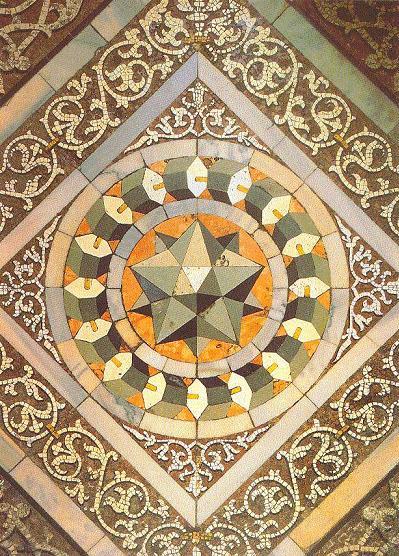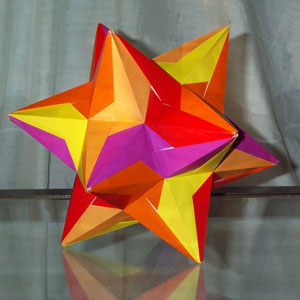|
|
|
The small stellated dodecahedron is the Kepler-Poinsot polyhedra whose dual polyhedron is the great dodecahedron. It is also uniform
polyhedron with Maeder index 34 (Maeder 1997), Wenninger index 20 (Wenninger
1989), Coxeter index 43 (Coxeter et al. 1954), and Har'El index 39 (Har'El
1993). The small stellated dodecahedron has Schläfli
symbol
and Wythoff symbol
. It is composed of 12 pentagrammic
faces (
).
It is the first stellation of the dodecahedron (Wenninger 1989).
The small stellated dodecahedron is implemented in the Wolfram Language as UniformPolyhedron[20],
UniformPolyhedron["SmallStellatedDodecahedron"],
UniformPolyhedron["Coxeter",
43
],
UniformPolyhedron[
"Kaleido",
39
],
UniformPolyhedron[
"Uniform",
34
],
or UniformPolyhedron[
"Wenninger",
20
].
It is also implemented in the Wolfram
Language as PolyhedronData["SmallStellatedDodecahedron"].

The small stellated dodecahedron appeared ca. 1430 as a mosaic by Paolo Uccello on the floor of San Marco cathedral, Venice (Muraro 1955). It was rediscovered by Kepler (who used th term "urchin") in his work Harmonice Mundi in 1619, and again by Poinsot in 1809.
The skeleton of the small stellated dodecahedron is isomorphic to the icosahedral graph.
Schläfli (1901, p. 134) did not recognize the small stellated dodecahedron as a regular solid because it violates the polyhedral formula, instead satisfying
|
(1)
|
where
is the number of vertices,
the number of edges, and
the number of faces (Coxeter 1973, p. 172).
Escher built his own model of the small stellated dodecahedron (Bool et al. 1982, p. 146) as a study for his woodcuts "Order and Chaos" (Bool et al. 1982, p. 299) and "Order and Chaos II" (Bool et al. 1982, p. 310).
The 12 pentagrammic faces can be constructing from an icosahedron by finding the 12 sets of five vertices that are coplanar and connecting each set to form a pentagram.
Taking the 12 pentagrams to have unit edge lengths, the circumradius of the small stellated dodecahedron is
|
(2)
| |||
|
(3)
|
A small stellated dodecahedron can be constructed by augmentation of a dodecahedron, i.e., building twelve pentagonal
pyramids and attaching them to the faces of the original dodecahedron. The height
of the pyramids for a small stellated dodecahedron built on a unit dodecahedron
is .
In order to achieve the same scale as the small stellated dodecahedron constructed
using pentagrams of unit edge lengths, the resulting augmented
solid built on the dodecahedron of unit edge lengths must be scaled by
.
Cumulating a unit dodecahedron to construct a great stellated dodecahedron produces a solid with edge lengths
|
(4)
| |||
|
(5)
|
The surface area and volume of such a small stellated dodecahedron are
|
(6)
| |||
|
(7)
|

The image above show an origami small stellated dodecahedron constructed using 30 36-degree isosceles triangle modules, each composed of a single sheet of paper, and requires glue (Gurkewitz and Arnstein 1995, pp. 54-55).
The convex hull of the small stellated dodecahedron is a regular icosahedron and the dual of the icosahedron is the dodecahedron, so the dual of the small stellated dodecahedron is one of the dodecahedron stellations (Wenninger 1983, p. 40)